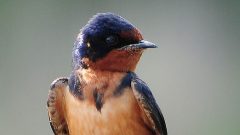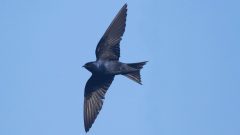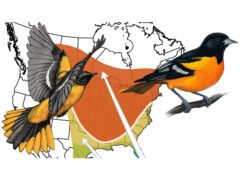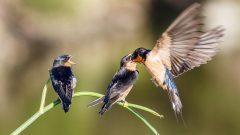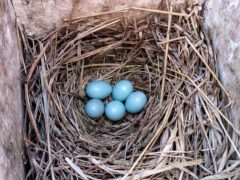Barn Swallow Similar Species Comparison
Main SpeciesBarn Swallow
Adult (American)
The most widespread and abundant swallow in the world, recognizable by its long, deeply forked tail and dark blue upperparts. Different subspecies groups vary in size, throat and underpart color, and length of tail streamers.
© Mason Maron / Macaulay LibraryWashington, April 24, 2020Adult (American)
Adult "American" Barn Swallows have a rusty forehead and throat, an incomplete breast band, and cinnamon underparts.
© Ryan Sanderson / Macaulay LibraryIndiana, June 03, 2020Adult
Upperparts are usually steely blue, but color changes with angle of light. Note long wings. At some times of year, some individuals lack the long tail streamers.
© Larry Arbanas / Macaulay LibraryCalifornia, December 01, 2005Adult (White-bellied)
Adult "White-bellied" Barn Swallows breeding in Europe, North Africa, and western Asia have a whitish belly and a thick blue band across the chest.
© Erkki Lehtovirta / Macaulay LibrarySouthwest Finland, June 19, 2019Adult (White-bellied)
Males and females are similar in appearance, but males have longer outer tail feathers than females
© Pavel Štěpánek / Macaulay LibraryZlínský kraj, May 12, 2018Adults (American)
Both males and females help build the nest, using pellets of mud combined with dry grasses.
© Larry Arbanas / Macaulay LibraryTexasAdult (Buff-bellied)
Adult "Buff-bellied" Barn Swallows breeding in East Asia are similar to "American" Barn Swallows in appearance, but have a larger rusty throat patch.
© Itamar Donitza / Macaulay LibraryMae Hong Son, March 25, 2015Adult (Tytler's)
Adult "Tytler's" Barn Swallows breeding in Siberia and northern Mongolia have reddish-orange underparts and a narrow, sometimes-broken breast band.
© Andrew Spencer / Macaulay LibraryBuryatia, June 18, 2017Adults (American)
Often forages in flocks, fairly low to the ground. Flight is very light and agile, with quick turns and little gliding.
© Timothy Barksdale / Macaulay LibraryTexas, April 27, 1997Adult (Levant)
Adult "Levant" Barn Swallows breeding in western Asia have rich orange underparts and a thick blue breast band.
© Eric Francois Roualet / Macaulay LibraryTel-Aviv, March 24, 2019Adult (Egyptian)
Adult "Egyptian" Barn Swallows have dark reddish-orange underparts and a thick dark blue breast band.
© Fabio Olmos / Macaulay LibraryQina, December 24, 2023Juveniles
Nests are made of mud and grass and usually placed under eaves, barn rafter, bridges, and culverts.
© Jay McGowan / Macaulay LibraryNew York, August 10, 2012Adult (American)
Slender-bodied with a long, deeply forked tail. From below, the underparts vary from pale cinnamon or tawny to bright cinnamon.
© Ad Konings / Macaulay LibraryTexas, August 20, 2020Adult (American)
Flies with fluid wingbeats making quick turns and dives; rarely glides. Tail is long and deeply forked with a white band across it.
© Ryan Sanderson / Macaulay LibraryIndiana, May 27, 2020Adult (White-bellied)
In flight, note "White-bellied" Barn Swallows' white underparts and white underwing coverts.
© Huw Roberts / Macaulay LibraryAbu Dhabi, April 21, 2018Juvenile (American)
Juvenile "American" Barn Swallows are dark above and pale cinnamon below with a rich rusty throat and forehead. Their tail is also shorter without the deep fork.
© Farshad Pourmalek / Macaulay LibraryBritish Columbia, July 10, 2019Immature (Levant)
Immatures are duller than adults and have shorter tails.
© yuda siliki / Macaulay LibraryHaifa, July 22, 2019Juvenile (White-bellied)
Juvenile "White-bellied" Barn Swallows have a white belly and tawny throat. The tail is also shorter without the deep fork.
© Teresa Cohen / Macaulay LibraryLisboa, April 14, 2017Juvenile (American)
Preferred nest sites include eaves, rafters, and cross beams of barns, sheds and stables, as well as the undersides of bridges, wharfs, and culverts.
© Laure Wilson Neish / Macaulay LibraryBritish Columbia, July 15, 2013Adult (American)
Long and slender with a deeply forked tail. In "American" Barn Swallows, the color of the underparts varies from buffy to rich cinnamon with the females typically having paler underparts.
© Ryan Sanderson / Macaulay LibraryIndiana, June 03, 2020Adult (American)
Collects mud in bill to build a mud and grass nest—often tucked under the eaves of barns and stables, on structures near playing fields, or under bridges.
© Jay McGowan / Macaulay LibraryNew York, May 23, 2017Flock (American)
Often seen in flocks in open habitats from fields, parks, and roadway edges to marshes, meadows, ponds, and coastal waters.
© George Gerdts / Macaulay LibraryWashington, August 12, 2017Similar SpeciesCliff Swallow
Adult
Cliff Swallows share the Barn Swallow's glossy blue upperparts and rusty throat, but the forehead is pale (not rusty) and the rump is cream (not dark blue).
© Dorian Anderson / Macaulay LibraryCalifornia, June 02, 2017Similar SpeciesCave Swallow
Adult
Cave Swallows have a paler rusty throat than Barn Swallows. Cave Swallows also have a square tail, lacking the Barn Swallow's forked tail.
© Joshua Covill / Macaulay LibraryTexas, April 28, 2017Similar SpeciesTree Swallow
Adult male
Tree Swallows lack the Barn Swallow's deeply forked tail and they have bright white (not cinnamon) underparts.
© Phil McNeil / Macaulay LibraryNew York, April 20, 2017Similar SpeciesViolet-green Swallow
Adult male
Violet-green Swallows lack the Barn Swallow's deeply forked tail and they have bright white (not cinnamon) underparts.
© Jason B Bidgood / Macaulay LibraryColorado, April 30, 2016Similar SpeciesChimney Swift
Adult/immature
Chimney Swifts have narrower, more curved wings and fly with much stiffer wingbeats than Barn Swallows. They are brown below unlike Barn Swallows which have tawny to cinnamon underparts.
© Steve Calver / Macaulay LibraryGeorgia, June 08, 2017Similar SpeciesVaux's Swift
Adult/immature
Vaux's Swifts have narrower, more curved wings and fly with much stiffer wingbeats than Barn Swallows. They are brown below unlike Barn Swallows which have tawny to cinnamon underparts.
© Roger Zachary / Macaulay LibraryCalifornia, June 29, 2017Compare with Similar Species
Click on an image to compare
Species in This Family
Swallows(Order: Passeriformes, Family: Hirundinidae)
More to Read
Don't miss a thing! Join our email list
The Cornell Lab will send you updates about birds,
birding, and opportunities to help bird conservation.










